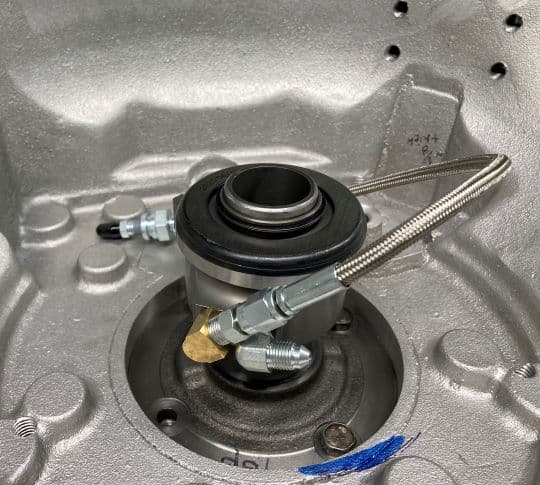I thought I had found a silver bullet in my goal to install the trans AFTER the bell was already in place. To clarify, I know from experience that in general, putting a trans onto the engine with the bell attached is a PITA because for one, the assembly is heavier and wieldier, and alignment is more difficult because clearances are tighter due to the width of the bell in the forward pocket near the engine. Alternately, when putting the trans on an already installed bellhousing, you’re working in a more accessible place under the car. It’s just easier to have a two-step process where you put the bell on, check its positioning and then mount the trans.
However.
The choice of using an internal hydraulic release bearing complicates things because that assembly, mounted on the front of the trans, can be too large to fit through the registration hole in the bellhousing. Bob B., using the two-step method, sidestepped this problem by pre-assembling the bearing in the bell, suspending it by its hydraulic hoses and threading the trans input shaft through the bearing support sleeve. See his post 137. This really gives me the heebee-jeebees! -especially since my bellhousing has no inspection hole to verify success.
But, trying to salvage the two-step method in my case, I realized there’s a subtle difference between Bob’s bellhousing and mine: The registration hole in my bell is sized for Ford T-5 which means it’s larger (4.9" vs GM 4.67") which, I thought, would give me enough clearance to fit the trans through the hole WITH the bearing installed on the trans. I could tie a cord to the hydraulic lines and snake them through the bell and out the side access holes. But I found two obstacles to this in the way the hydraulic lines connect to the bearing: First, there are adapter fittings that come straight out radially and exceed the hole boundary. To correct this, I thought I could use angled fittings (the aforementioned silver bullet). But second, as the pictures show, the hydraulic ports are too close together to install both of these fittings. The first one goes in OK but it stands in the way of putting on the second. I found a street elbow fitting which is small enough to screw in next to the angled fitting but the assembly is still a tight fit and would require cutting the bellhousing for extra clearance (blue mark in the picture). I don’t like this idea.

I found another non-advantage for me in following this track: In “rehearsing” checking the bellhousing runout with the clutch installed, I tried to mount my dial indicator on washers clamped to the diaphragm spring the way Bob did (his post 219) but I could not get consistent readings because the magnetic base would not stay put. I futzed with this for hours wondering if the bellhousing was really that far off. ( I had checked it when new and had to install .021 offset dowels to bring it within .005" TIR)
So, I stripped all the parts off and mounted a plate I had previously made to the crankshaft. It’s tapped to accept the indicator post without the base; won’t slip! I re-installed the bell and rechecked the runout. I got .002", which gave me confidence that the bell positioning is robust and repeatable. One reason may be that the dowels are very tight in the bores and don’t move unless you were to drive them out
 Red/ Black -lateral/radial runout
Red/ Black -lateral/radial runout
All of the above means, as unsavory as it seems, I’m leaning toward installing the bell and trans assembled. That way, I can route the bearing and hydraulic lines in a neat and orderly way on the bench and avoid hacking up my bellhousing.
However, I realize as I write this(cartoon lightbulb over my head) that I could try the Phoenix two-step, not worry about the bell measurement, and see if I can successfully skewer the bearing tube. I’ll call it Option 3. If it doesn’t work out, I can regroup. -cross that bridge when I come to it.














 Red/ Black -lateral/radial runout
Red/ Black -lateral/radial runout